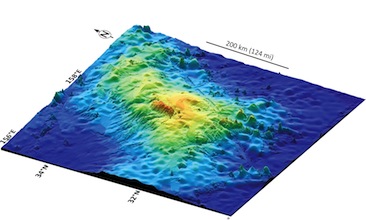A University of Houston (UH) professor led a team of scientists to uncover the largest single volcano yet documented on Earth. Covering an area roughly equivalent to the British Isles or the state of New Mexico, this volcano, dubbed the Tamu Massif, is nearly as big as the giant volcanoes of Mars, placing it among the largest in the Solar System.
William Sager, a professor in the Department of Earth and Atmospheric Sciences at UH, first began studying the volcano about 20 years ago at Texas A&M’s College of Geosciences. Sager and his team’s findings appear in the Sept. 8 issue of Nature Geoscience, the monthly multi-disciplinary journal reflecting disciplines within the geosciences.
Located about 1,000 miles east of Japan, Tamu Massif is the largest feature of Shatsky Rise, an underwater mountain range formed 130 to 145 million years ago by the eruption of several underwater volcanoes. Until now, it was unclear whether Tamu Massif was a single volcano, or a composite of many eruption points. By integrating several sources of evidence, including core samples and data collected on board the JOIDES Resolution research ship, the authors have confirmed that the mass of basalt that constitutes Tamu Massif did indeed erupt from a single source near the center. 
Tamu Massif stands out among underwater volcanoes not just for its size, but also its shape. It is low and broad, meaning that the erupted lava flows must have traveled long distances compared to most other volcanoes on Earth. The seafloor is dotted with thousands of underwater volcanoes, or seamounts, most of which are small and steep compared to the low, broad expanse of Tamu Massif.
“It’s not high, but very wide, so the flank slopes are very gradual,” Sager said. “In fact, if you were standing on its flank, you would have trouble telling which way is downhill. We know that it is a single immense volcano constructed from massive lava flows that emanated from the center of the volcano to form a broad, shield-like shape. Before now, we didn't know this because oceanic plateaus are huge features hidden beneath the sea. They have found a good place to hide.”
Tamu Massif covers an area of about 120,000 square miles. By comparison, Hawaii’s Mauna Loa – the largest active volcano on Earth – is approximately 2,000 square miles, or roughly 2 percent the size of Tamu Massif. To find a worthy comparison, one must look skyward to the planet Mars, home to Olympus Mons. That giant volcano, which is visible on a clear night with a good backyard telescope, is only about 25 percent larger by volume than Tamu Massif. 
According to Sager, Tamu Massif is believed to be about 145 million years old, and it became inactive within a few million years after it was formed. Its top lies about 6,500 feet below the ocean surface, while much of its base is believed to be in waters that are almost four miles deep.
“It’s shape is different from any other sub-marine volcano found on Earth, and it’s very possible it can give us some clues about how massive volcanoes can form,” Sager said. “An immense amount of magma came from the center, and this magma had to have come from the Earth’s mantle. So this is important information for geologists trying to understand how the Earth’s interior works.”
The project was funded by the National Science Foundation, both through direct grants and through its Integrated Ocean Drilling Program, an international research program dedicated to advancing scientific understanding of the Earth through drilling, coring and monitoring the subsea floor.
###
Additional Contacts for Media Inquiries:
Will Sager, wwsager@uh.edu or 713-893-0717
Matt Wright, mwright@oceanleadership.org or 202-448-1254
Karen Riedel, kriedel@tamu.edu or 979-845-0910
Keith Randall, keith-randall@tamu.edu or 979-845-4644
About the University of Houston
The University of Houston is a Carnegie-designated Tier One public research university recognized by The Princeton Review as one of the nation’s best colleges for undergraduate education. UH serves the globally competitive Houston and Gulf Coast Region by providing world-class faculty, experiential learning and strategic industry partnerships. Located in the nation’s fourth-largest city, UH serves more than 40,700 students in the most ethnically and culturally diverse region in the country. For more information about UH, visit the university’s newsroom at http://www.uh.edu/news-events/.
About the College of Natural Sciences and Mathematics
The UH College of Natural Sciences and Mathematics, with 193 ranked faculty and nearly 6,000 students, offers bachelor’s, master’s and doctoral degrees in the natural sciences, computational sciences and mathematics. Faculty members in the departments of biology and biochemistry, chemistry, computer science, earth and atmospheric sciences, mathematics and physics conduct internationally recognized research in collaboration with industry, Texas Medical Center institutions, NASA and others worldwide.
To receive UH science news via email, sign up for UH-SciNews.
For additional news alerts about UH, follow us on Facebook and Twitter.
